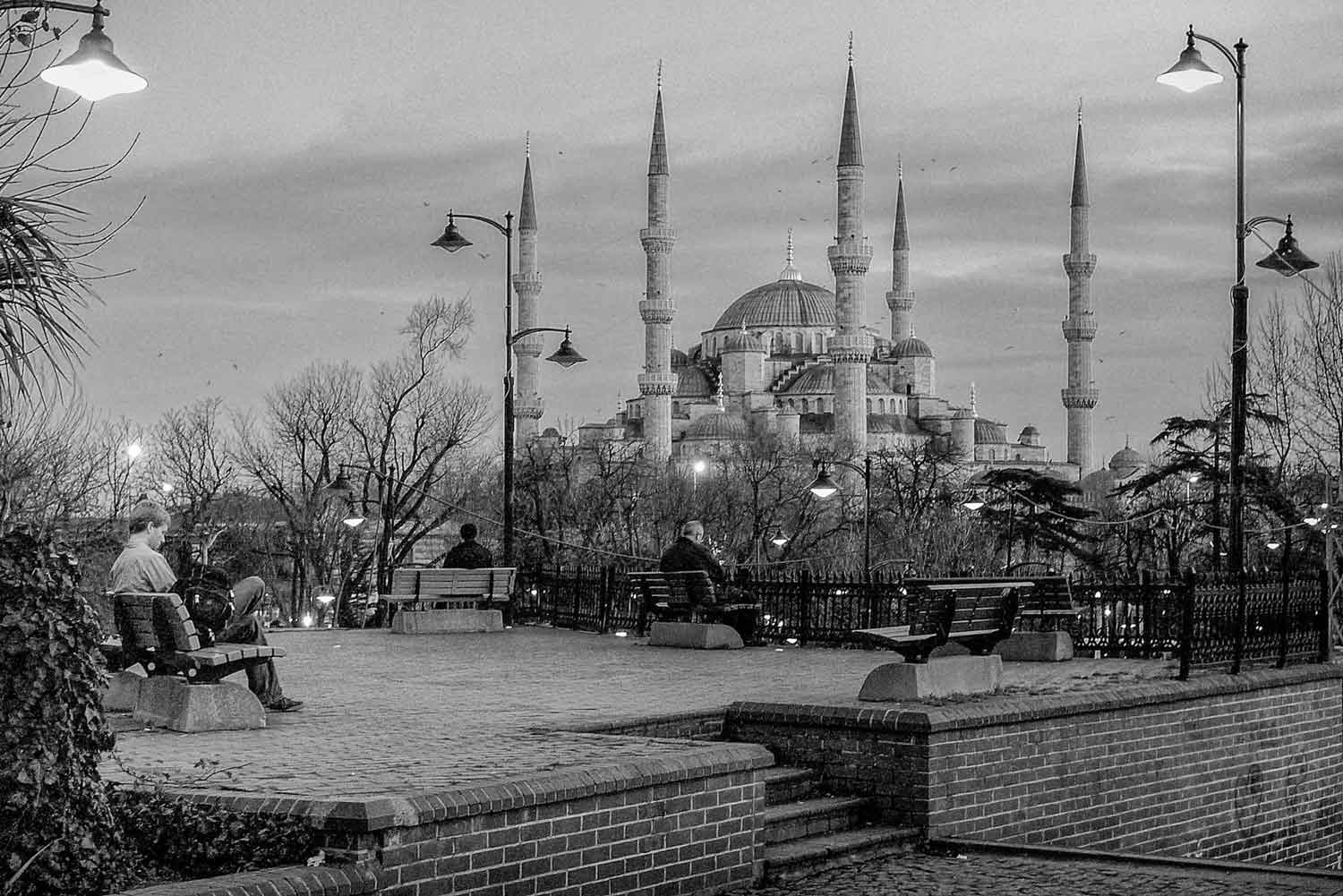Wandering About in Sultanahmet, Istanbul
His cry rode a long time on each breath and dipped and rose and turned and twisted in the sweet manner of an endless Hindusthani strain and my mind came to a halt and listened, rapt.

I bought warm chestnuts from a steaming cart in the empty Aya Sofya Square and walked over to the benches before the Blue Mosque, where there were only three others, sitting on the benches and meditating on the mosque. I shivered in spite of the layers of clothes and marveled at the mosque lit by electric lights from below, and from the sky by the stars and a classic crescent moon. I felt alright. At this time there were no more touts to ask me in their pleasant but pesky way: Where you from? India? Pakistan? (And once, Jordan?) The mosque was aloof, unaffected by the white birds wheeling over it, focused only on its relentless effort to stare off the Aya Sofya, just as the Aya Sofya has stared at the Blue Mosque for five hundred years. The Blue Mosque is Aya Sofya’s junior by a thousand years but is as tall and more handsome with six minars to Aya Sofya’s four.
The muezzin’s call broke the still night. His cry rode a long time on each breath and dipped and rose and turned and twisted in the sweet manner of an endless Hindusthani strain and my mind came to a halt and listened, rapt. When finally his strains faded the call began from a distant mosque in a complementary pitch and went just as far, and matched the circuitous route of its rival, volume diminished by distance, and when that voice faded the Blue Mosque came on back, and the performance went on thus, a long time, the two phantoms making all Sultanahmet a stage for their duet.
Three days later I went to the Suleymaniye Mosque but didn’t enter it. My legs took control of my absent mind and took me to the corner to the tombs of Hurrem and Suleyman the Magnificent. Modest tombs, if you consider the style and scale of the arrangements the Moghul emperors made for themselves in India. I stared at the marble and thought, Is she there really, are her bones down below these stones, am I standing so close to her? I wondered if it was correct to hang the story of her infamy on her tomb: how she came to be a concubine, how she became the emperor’s wife, the manner in which she arranged the crown for Selim her son (which was to ask Suleyman to kill his eldest son Mustafa), her plot with her son-in-law to kill the Grand Vizier. Her tomb fronts the famous Suleymaniye Mosque which was her doing and where a grand restoration is going on, and the story lists her other works, many of which were executed by Mimar Sinan, the great architect. Her correspondence reveals an influence beyond the Ottoman Empire, and a total command over the Sultan. The scaffolding runs the full height of the minars, to restore and appropriate her work for humanity, as its heritage.
I went to see the whirling dervishes not knowing what to expect. The show was in the Sirkeci Railway Station, in a large bare hall, quiet for a hall in a train station. During the hushed wait for commencement a cat played with one of the rugs lined on the floor. The musicians sat on a line of plain chairs, just like us the audience. They performed without the dervishes for a half-hour, singing not too loud, seizing us with the movement of pitch and with a lively pacing. The dervishes entered, robed and tall hatted, so slow, almost somnambulant. They squatted on the rugs and then rose and arranged themselves on the floor and began the whirl. One hand raised and cupped toward the head, the other hand limp and flat, the arms extended, a simple foot action, round and round and round with eyes half closed, music and singing in the background, that is the whirl of the dervish. No hint of monuments, of palaces, no ornamentation, no splendor, just coarse garments, only worship, only love.
The Sirkeci train station is by the Bosphorus, barricaded from it by the strip of Kennedy Caddesi. Pierre Loti wrote in the nineteenth century that the Bosphorus flows at the feet of Istanbul. Leaving the dervishes and turning my back on the Bosphorus and walking up to Aya Sofya Square to reach my hotel on the dip beyond the Square, it more appeared to me that the Byzantines and the Ottomans put their palaces and monuments on a perch on high ground and ruled from there so the Bosphorus couldn’t get to them. Her brother Time got them, after he’d given generously of himself to both empires.
The new spirit of Istanbul may be sensed, I am told, across the river in Beyoglu, which is on the European side of Istanbul, and Europe is where the Istanbullus have flung their heart. My next days are booked in a business hotel in Beyoglu.
